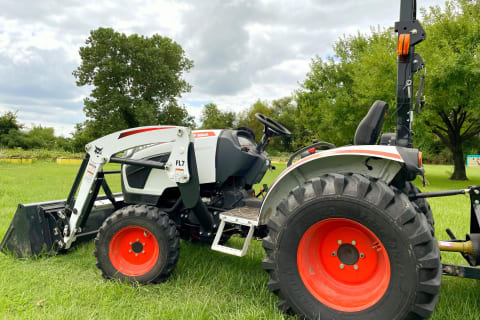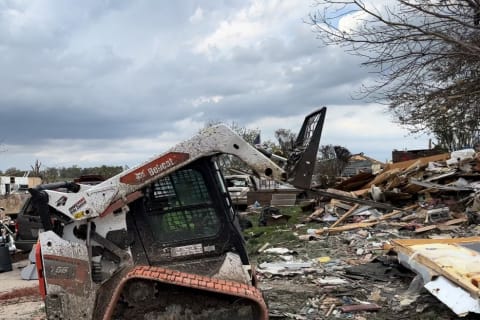- Home
- Company
- News & Media
- Bobcat Stories
- North Carolina Crew Constructs Fast-Food Restaurants in Fewer Than 100 Days
North Carolina Crew Constructs Fast-Food Restaurants in Fewer Than 100 Days
Published on May 17, 2019
There is an important clock that starts ticking with a heightened sense of urgency for Tom Westmoreland. It’s not his alarm, but a fast-approaching deadline. In fewer than 100 days, an existing fast-food restaurant must be torn down and a new building constructed and open for business.
But the president of J. Westmoreland doesn’t even break a sweat at this tight schedule. He grew up putting in long hours and getting his hands dirty helping his father, Jim Westmoreland, on his 80-acre farm in Kernersville, North Carolina. In addition to farming, he worked part-time at his father’s septic tank installation company, which was started in 1967. While Tom was in college, he took over his father’s booming business, hired a handful of employees and bought multiple Bobcat skid-steer loaders to complete residential septic installation and commercial grading projects.
“The company was doing quite well until the Great Recession hit (2008) and the housing market slowed,” Tom says. “I was concerned about our future.”
Just when he was contemplating his next move, a chance encounter poised the company for success: He met Larry Vickery, senior vice president of Venture Construction Company – a general contracting company specializing in restaurant and retail construction.
“Vickery had asked me to complete work on his house,” Tom says. “At the time, he was on the board of the Kernersville Methodist Church, and they had a building project that required demolishing houses. They passed down my contact information to one of the project managers who showed me how to do commercial work.”
Once Tom and his crew got the hang of commercial building projects, primarily fast-food restaurants, new projects started flooding in.
“Only a few years ago our company worked for one or two contractors, but now we have worked our way to eight,” he says. “Our relationship with Venture Construction has led to a profitable partnership over the years, allowing us to grow our business.”
One decade later, the companies have completed more than 300 projects together, including constructing more than 100 McDonald’s restaurants as well as multiple Bojangles, Burger King, Chick-Fil-A, Taco Bell and Wendy’s restaurants.
Building a Competitive Advantage With Bobcat Equipment
J. Westmoreland completes approximately 90% of the reconstruction of McDonald’s restaurants located in a 100-mile radius of Kernersville. To keep the revenue needle moving, the company’s assignment on each job is to tear down the existing structure, re-grade the entire property, dig footings, improve drainage systems and enlarge the property.
The company has such a large volume of work – enough to put eight to 10 crews out on a variety of jobsites each day – that the need for efficient equipment was critical. Tom selected machines he grew up using and knew best: Bobcat equipment.
“We purchased our first Bobcat skid-steer loader in 1974 from Piedmont Bobcat sales specialist Dennis Tuttle and haven’t looked back since,” he says. “Our first loader pushed through the toughest of jobsites over the years and gave us a competitive advantage over larger equipment, helping us win more bids. Our transition to a commercial-only business was easy because we had invested wisely in Bobcat equipment early on.”
The Westmorelands have continued to add Bobcat machines to their fleet to finish projects in a timely manner. Today, the company has approximately 34 pieces of equipment, including its most recent purchase of two T740 compact track loaders. In addition, the company is also leasing two E50 compact excavators – the first time the company has leased equipment.
“We have always prided ourselves in buying equipment, but leasing the two excavators just made sense for our business,” Tom says. “Leasing was new to us but has allowed us to try out the newest machines, while building up our business.”
Efficient Equipment, Fast Results
With the help of Bobcat machines, Tom and his 33 employees have been able to exceed project deadlines on a variety of McDonald’s restaurant reconstruction projects. After the existing building has been demoed by larger crawler excavators, Tom then deploys compact track loaders equipped with hydraulic breakers to break up smaller pieces of concrete.
Afterward, multiple Bobcat skid-steer loaders are paired with buckets and pallet forks to pick up and place demolition debris in haul trucks which then move the material off-site to J. Westmoreland’s land clearing and inert debris landfill. At the landfill, the company screens excess dirt as well as crushes concrete, asphalt and untreated wood, before selling it to neighboring towns.
“I’ve always thought Bobcat equipment was top-of-the-line,” Tom says. “This has proven true over the years. Overall, we have produced a higher profit using compact loaders than some of our larger machines. The loaders we own are very versatile and efficient when working in conjunction with other workers and equipment on-site. We can load haul trucks twice as fast using our compact loaders than larger wheel loaders on the jobsite. There is a reason I own so many Bobcat loaders – they produce results on the job and in the pocketbook.”
After the debris is removed from the jobsite, two T740 compact track loaders get to work backfilling the basement and grading the property.
“The T740s have helped us work long hours on the jobsite,” Tom says. “The loaders can easily lift loads of excess dirt higher into our haul trucks, which comes in handy before we start backfilling the jobsite. Plus, Selectable Joystick Controls were a necessity on both machines to help reduce operator fatigue since our operators are working day, night and weekend shifts at times.”
Once the company backfills the area, an E50 compact excavator configured with the extendable-arm option starts digging the footings. Venture Construction typically gives J. Westmoreland only two days to dig and install the footings at a specific project.
“My crew would not be able to finish portions of the project in such an efficient manner without the Bobcat machines,” Tom says. “The excavators can get up to 30 inches of reach at full extension without the need to reposition, which is a huge time and cost savings. There is no wasted motion, allowing us to move forward to the next phase of construction.”
Fast-food construction allows little room for error or project delays, Tom says, so J. Westmoreland counts on reliable equipment to make sure restaurants open for business on time and start generating income as soon as possible.
“It’s important to our clients that we have the right fleet on the jobsite to get the work done quickly,” he says. “Their consumers want to return to their favorite fast-food restaurant, and we can do that in a quick and efficient manner. We bring a different kind of fast to the jobsite.”
More Recent Stories
View All Stories- Bobcat Superfan Hits a ‘Homerun’ With Bobcat Equipment
Bobcat Superfan Hits a ‘Homerun’ With Bobcat Equipment
From Syria to Kentucky, Mohamed Edelbi’s built a thriving landscaping and excavation business with Bobcat equipment, crediting dealer support for his success. - Turning Acreage into a Homestead with Bobcat T66 Loader
Turning Acreage into a Homestead with Bobcat T66 Loader
Discover how partners John Lange and Janessa Denman transformed their 44-acre homestead into a forever home with their Bobcat T66 compact track loader and attachments. - Ringers Landscaping Doubles Revenue with Bobcat Equipment
Ringers Landscaping Doubles Revenue with Bobcat Equipment
Ringers Landscaping doubled revenue in three years by optimizing operations and achieving an increase of 40% efficiency with Bobcat equipment and attachments. - Childhood Friends Become Landscaping Pros with Bobcat Equipment
Childhood Friends Become Landscaping Pros with Bobcat Equipment
Childhood friends Anthony Heathco and Colton Roush founded Roadkill Lawncare & Landscaping in Grand Junction, Colorado, starting with a Bobcat® MT100. - Rocky Mountain Stonecrete Completes Challenging Jobs with Bobcat Equipment
Rocky Mountain Stonecrete Completes Challenging Jobs with Bobcat Equipment
Founded in 2006 by Eric Niemann, Rocky Mountain Stonecrete has grown with Bobcat equipment and his loyal crew, by taking on challenging jobs that scare other contractors. - Houston-Based Sweetwater Farms HTX Combines Agriculture with Education
Houston-Based Sweetwater Farms HTX Combines Agriculture with Education
With the help of volunteers, friends, and a brand-new Bobcat® compact tractor, Chaz Daughtry is taking the Houston agriculture scene by storm. - Bobcat Mowers Expands CLK Lawn Care and Landscaping Business
Bobcat Mowers Expands CLK Lawn Care and Landscaping Business
Cody Kuebler started CLK Lawn Care and Landscaping at the age of 11, he expanded his business with two Bobcat ZS4000 Mowers and now his team only uses Bobcat mowers. - Omaha Contractors Provide Tornado Relief with Bobcat Equipment
Omaha Contractors Provide Tornado Relief with Bobcat Equipment
Local contractors in Omaha, Nebraska, including Ideal Construction and Mitera Landscaping, rallied with Bobcat machines to aid in tornado cleanup and community support. - Bobcat Compact Tractor Provides Solace for Mobile Crisis Clinician
Bobcat Compact Tractor Provides Solace for Mobile Crisis Clinician
Therese Swift, a mobile crisis clinician, mitigates work stress by tending to her horses and mules, with her Bobcat CT4045 compact tractor aiding in the upkeep. - Shades of Green Nursery Unites Community with Bobcat Equipment
Shades of Green Nursery Unites Community with Bobcat Equipment
At Shades of Green Nursery, founder Julie Holland uses Bobcat equipment to unite the community in Celina, Texas with inclusive gardening practices that support the local ecosystem.
What’s Your Bobcat Story?
Taking on big, ambitious challenges is what being One Tough Animal® is all about. Tell us how Bobcat empowers or inspires you to accomplish more. Whether it’s at work, at play or in life, share your story with us.
Share Your Story








